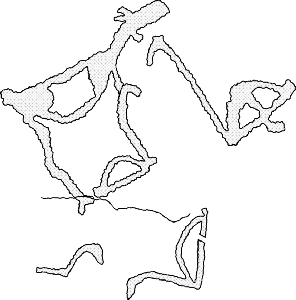-
Extinct Beliefs of Prehistoric Hunter's in the Rock Pictures of Lake Onega.
Väino Poikalainen
The Karelian Republic in North-East
Russia is famous for two Stone Age rock art territories about
5000-6000 years old. One lies close to the White Sea at the mouth of
the River Vyg and the other on the Eastern shore of Lake Onega.
Despite some similarities, both have clearly specific features.
Carvings of the White Sea rock art territory depict various marine
themes and many of them create dynamic compositions in which the
sequence of time is conveyed by footprints, ski tracks and other
traces. The rock carvings of Lake Onega, about 330 km to the south,
represent a more static art rich in waterfowl images, abstract
signs and beautiful compositions full of hidden meanings
(Fig. 1).
Studying Lake Onega rock art has come a long way since the first
descriptions 150 years ago. During this period the number of known
carvings and sites has constantly grown, as has the territory of
discovered rock art. The preliminary opinions of «petty
petroglyphs on the periphery of Northern Europe» have become a
conviction that these are some of the most valuable rock art samples
from the hunter-gatherer era in the Northern Hemisphere. Today they
are seen as a prehistoric open-air sanctuary or sanctuaries.
The Estonian Society of Prehistoric Art has
published a new book:
"Rock Carvings of Lake Onega. The Vodla Region"
by Väino Poikalainen and Enn Ernits, which
is the first part of the planned 3-volume series about this petroglyph
territory. The current volume (432 pages) consists of a survey of the
Neolithic rock art of Lake Onega and a catalogue of the petroglyphs of the
Vodla region. This region is the less known, northernmost part of the entire
rock art territory, and includes the Kochkov-Navolok peninsula and the
Bolshoi Golets island of the Shalskiye Ostrova islands. The
structure of the catalogue is based on multi-layer
graphic information from a general map to separate carvings united by a grid
network.
All carvings have a graphic representation with
characteristic parameters added to it as well as a verbal
description.
Verbal description of biomorphs is based on international terminology used in
human and veterinary anatomy.
Details of the description method were worked out, the general survey
conducted and description of the carvings written by Enn Ernits.
Carving, group and site documentation was systematised and converted
to computer graphics, parametrics determined, localities and sites
described and the catalogue compiled by Väino Poikalainen.
Data concerning separate carvings, groups and sites was compiled mostly in
1993-1995. In the same period parametrical documentation of the
carvings accomplishe.
Material collected by earlier expeditions of the Estonian Society of
Prehistoric Art was used, too.
Recorded
photometric material was converted to computer graphics and carving
descriptions written in 1995-1997.
The main goal of the book is to
serve as the basis for further studies in rock art, prehistoric
religion, archaelology, history of art, protection of rock art, etc.
The publication can be ordered at the price of 57 US $ (plus 9$ in
Europe and 12$ elsewhere for postage expences):
Väino Poikalainen
P.O. Box 192
Tartu
Estonia |
E-mail address: poika@obs.ee
or sending a telefax to
372-7-493569.
|
|

Fig. 1. A carving composition from the Northern
Cape Swan site. |
|